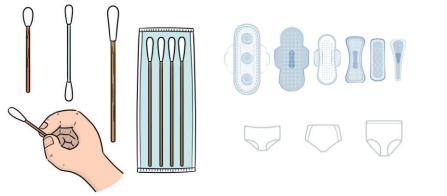- Understand hysterectomy and anterior and posterior vaginal wall repair surgery. the uterus is removed through the vagina andsutured from the bottom of the vagina to repair the anterior and posterior vaginal walls.
- Learn the precautions for post-operative care. for example, on the second day after the operation, start taking a warm sitz bath according to the doctor's instructions, and it needs to last for two weeks.
- Learn the precautions for discharge care. If you have fever, wound suppuration, severe pain in the lower abdomen, or heavy vaginal bleeding, you should go to the emergency room for medical treatment.
I. Introduction of surgery:
Uterine prolapse refers to the uterus prolapse and fall into the vagina, or refers to the tissue adjacent to the vagina bulging to the vagina. Symptoms include pain, frequent urination, vaginal discharge and falling sensation. The causes are: advanced age, menopausal muscle fiber tissue congenital relaxation, multiple pregnancy and probiotic effects. For uterine prolapse after menopause or no longer giving birth, the most common surgical procedure is transvaginal resection of the uterus & anterior & posterior vaginal wall repair surgery. The surgical method does not require cutting the abdomen, but the uterus is removed through the vagina and sutured from under the vagina to repair the anterior and posterior wall of the vagina.
II. Preparations before the surgical surgery:
| Skin preparation | Preoperative shaving of the pubic site before operation day |
| Preparation |
□oral cotton tips □disposable underwear □sanitary napkins □rinse pots
|
| Bowel |
The night before surgery, nursing staff will provide you enema to clean the intestine.
Do not have food or water for 8 hours before surgery.
|
III. Care after surgery:
- After the vagina surgery, a gauze would be placed in your vagina for compression purpose temporarily. The gauze will be removed in the coming morning after the surgery. It is normal to have a small amount of vaginal discharge.
- Please inform the medical staff if you notice excessive discharge from vagina.
- Aside from taking medication, you can also try perform a sitz bath the next day after the operation. To perform a sitz bath you will need a bathtub or a shallow basin.
- The following steps will guide you through the process of sitz bath:
- Fill the shallow bucket with warm water until the bucket is half full. The water should be warm but not hot enough to cause burs or discomfort. Keep your water temperature 41-43°C.
- Soak the perineum for 15 to 20 minutes two to four times a day during the acute phase.
- It is not necessary to add any medicine or disinfectant in the warm water.
- If you defecate, your perineum needs to be cleaned and you should take sitz bath one more time.
- Doctors will prescribe pain medication for you. Please inform the nurses if you still feel pain after the medication.
- Assess your pain by 10 point pain scale, inform the nurse when you feel pain.
- After surgery, you can use oral cotton tips with water to moisten your mouth or lips.
- Your surgeon will tell you the diet steps after surgery. You can drink some liquid after the doctor assessment.
- If you have no throw up or abdominal distension, you can eat normally. You need to avoid flatulence foods such as milk, sweet potato and soy milk.
- You may feel sore throat and much secretion after general anesthesia. Regularly practice deep breathing and coughing taught by the nurse to prevent pulmonary complications after the surgery.
- Your vagina may have some bloody discharge, change your sanitary nap frequently and keep the perineum clean to avoid infection.
- Avoid changing position too fast, get out of bed gradually (Sitting on the bed about 5 minutes first, then move to sit on bed side about 5 minutes, standing up about 5 minutes). If feeling dizzy, please take a rest immediately.
- Fix the catheter and avoid it from being twisted in case of causing clog. (Urine catheter may insert for 2-3 days.)
- After secondary urine, the nurse will measure the volume of bladder residual urine with the bladder scan. Check the amount of urine.
- The doctor will adjust the oral medication or re-insert the catheter as needed, if not improved, the bladder training would be carried out.
IV. Things you should pay attention to:
- Keep the perineum clean, sitz bath should last for 2 weeks.
- If the following conditions occur, you should go to see the doctor: (1) fever; (2) wound infection; (3) lower abdomen sharp pain; (4) large amount of vagina bleeding.
- After the surgery, please avoid heavy lifting or strenuous exercises for 4 to 6 weeks.
- Make return visit on time, resum sexual life after doctor assessment.
- Consult the medical staff at any time if you have any problem.
- (04)23592525#5801
- (04)23592525#8086 or #8076
V. Conclusion:
After returning home, you need to keep the perineum clean, and take a warm water hip bath for 2 weeks. During the warm water hip bath, if you feel weak, sweating, palpitations, or bleeding profusely, please stop soaking in the tub.
VI. Reference:
- 張紫婷、陳尹甄、郭素真‧(2019)‧決策輔助工具在骨盆腔器官脫垂婦女醫病共享決策之應用成效‧榮總護理,36(4), 353-360。
- Naik, N. G., Mane, A. Y., & Gupte, N. (2020). Retrospective observational study to evaluate the concept of the warm versus regular room temperature seitz bath in perineal wound healing. International Surgery Journal, 7(10), 3230-3233.
Let's proceed with the assessment to ensure that you have a thorough understanding.
- 位置
-
- 資料夾名稱
- English
- 上傳者
- 許帆媗
- 單位
- 中榮護理衛教
- 英文名稱
- Post-Operative Instructions for Patients Who Have Uterine Prolapse Surgery
- 分類
- 手術
- 科別
- 英語
- 癌症照護
- 否
- 建立
- 2024-01-30 05:39:22
- 制訂日期
- 2009-04-24
- 最近修訂
- 2024-03-19 11:52:00
